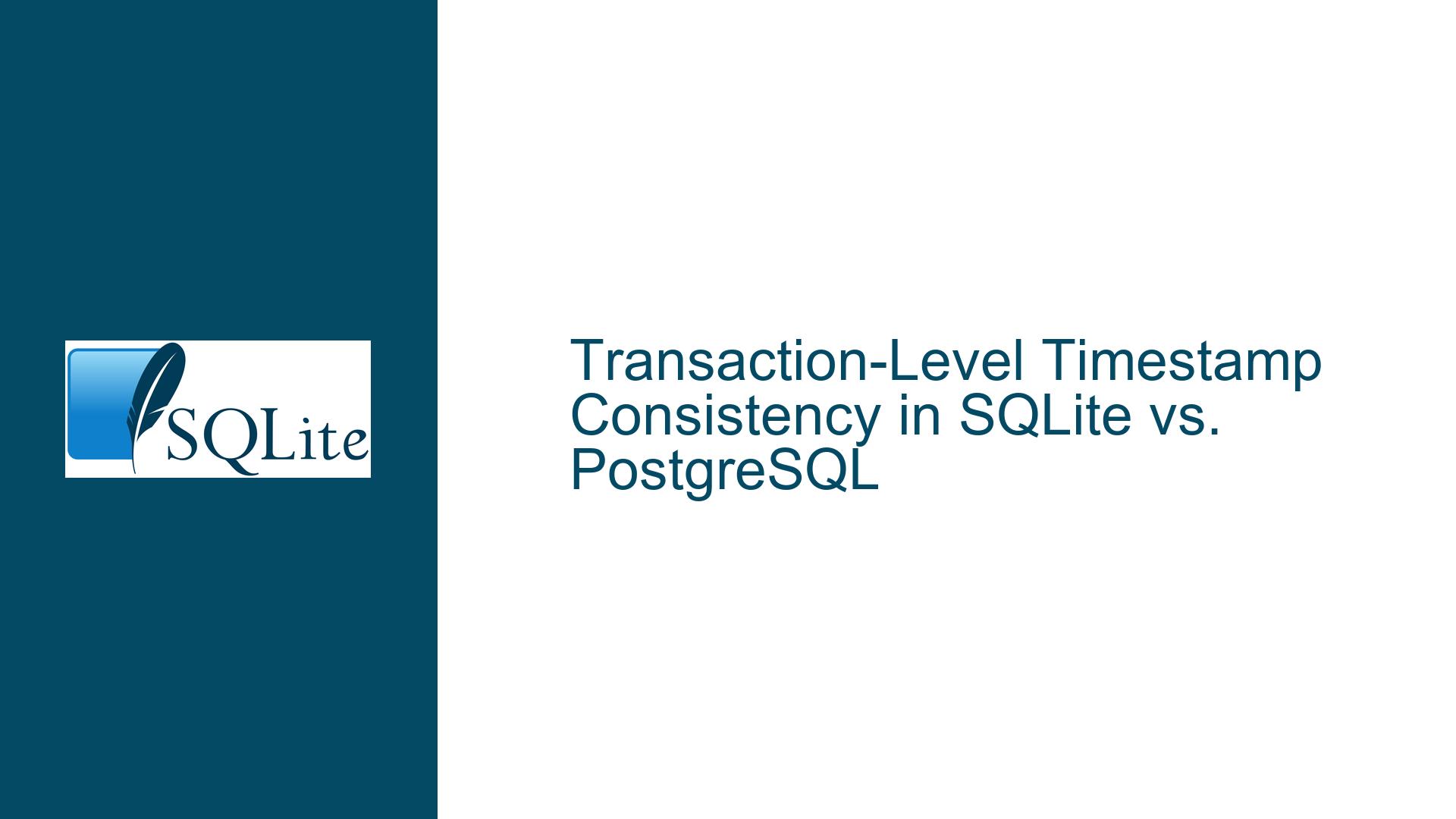Transaction-Level Timestamp Consistency in SQLite vs. PostgreSQL
Understanding Timestamp Stability in SQLite and PostgreSQL
Core Issue: Step vs. Transaction Stability
SQLite and PostgreSQL differ fundamentally in how they handle temporal functions like NOW(), CURRENT_TIMESTAMP, and datetime('now').
SQLite Behavior (Step Stability)
- The
datetime('now')function returns the exact same value for all calls within a singlesqlite3_step()operation (i.e., during the execution of one row retrieval in a query). - Example:
SELECT *, julianday('now') - julianday(modification) AS age FROM player;If this query processes 1,000 rows,
julianday('now')may update multiple times during execution, leading to inconsistent age calculations.
- The
PostgreSQL Behavior (Transaction Stability)
NOW()returns the start time of the transaction for all calls within that transaction.- Guarantees consistency: All modifications in a transaction share the same timestamp.
Why This Matters
Applications expecting PostgreSQL-like behavior may encounter:
- Inconsistent timestamps across related updates/inserts.
- Drift in time-sensitive calculations (e.g., session expiration checks).
Root Causes of SQLite’s Timestamp Behavior
Step-Level Time Retrieval
SQLite fetches the current time from the Virtual File System (VFS) each timesqlite3_step()is called, unless optimized as a constant.Absence of Transaction Timestamp Storage
Unlike PostgreSQL, SQLite doesn’t store a “transaction start time” at the connection level.Autocommit Mode Interactions
- Implicit transactions (autocommit mode) reset timestamps for each statement.
- Explicit transactions (
BEGIN/COMMIT) don’t freeze timestamps unless manually managed.
Backward Compatibility Constraints
Changingdatetime('now')to be transaction-stable would break existing applications relying on step-level behavior (e.g., long-running queries expecting real-time updates).
Solutions for Consistent Timestamps in SQLite
1. Manual Timestamp Binding
Capture the timestamp at the start of the transaction and propagate it via bound parameters.
Steps:
- Fetch the timestamp before starting the transaction:
sqlite3_int64 txn_time; sqlite3OsCurrentTimeInt64(db->pVfs, &txn_time); - Use this value in all subsequent operations:
UPDATE player SET score = score + 1, modification = ?; - Advantage: Full control over timestamp consistency.
- Drawback: Requires application-level changes.
2. Custom “Transaction Time” Function
Implement a txn modifier via SQLite’s extension API or source modification.
Patch Example (abridged):
Index: src/date.c
===================================================================
--- src/date.c
+++ src/date.c
@@ -379,10 +379,30 @@
return 0;
}else{
return 1;
}
}
+
+static int setDateTimeToTransaction(sqlite3_context *context, DateTime *p){
+ p->iJD = sqlite3ConnCurrentTime(context);
+ if( p->iJD>0 ){
+ p->validJD = 1;
+ return 0;
+ }else{
+ return 1;
+ }
+}
+
static int parseModifier(
sqlite3_context *context,
const char *zMod,
DateTime *p
){
@@ -439,10 +459,12 @@
return 0;
}else if( !context ){
return 1;
}else if( sqlite3StrICmp(zDate,"now")==0 && sqlite3NotPureFunc(context) ){
return setDateTimeToCurrent(context, p);
+ }else if( sqlite3StrICmp(zDate,"txn")==0 && sqlite3NotPureFunc(context) ){
+ return context->pVdbe->db->autoCommit ? setDateTimeToCurrent(context, p) : setDateTimeToTransaction(context, p);
#ifndef SQLITE_OMIT_LOCALTIME
}else if( sqlite3StrICmp(zDate, "local")==0 && sqlite3NotPureFunc(context) ){
if(setDateTimeToCurrent(context, p)==0) return toLocaltime(p, context);
#endif
}else if( strchr(zDate, '/')>0 ) {
Usage:
SELECT datetime('txn'); -- Returns the transaction start time
Behavior:
txnuses a connection-level timestamp reset when a transaction begins.- Falls back to
nowsemantics in autocommit mode.
3. Modify CURRENT_TIMESTAMP Semantics
Adjust CURRENT_TIMESTAMP to use transaction-level stability via compile-time options or pragmas.
Code Change:
// In date.c, change the handling of CURRENT_TIMESTAMP
- datetimeFunc(context, 0, 0);
+ datetimeFunc(context, -1, 0); // Force 'txn' semantics
Considerations:
- May break applications relying on step-level
CURRENT_TIMESTAMP. - Use a pragma (e.g.,
PRAGMA legacy_timestamp_behavior=ON) to revert.
4. Application-Level Transaction Time Tracking
Store the transaction start time in the application layer and use it in SQL:
# Python example using sqlite3
import sqlite3
import time
conn = sqlite3.connect('test.db')
conn.execute('CREATE TABLE events (id INTEGER, ts TEXT)')
txn_time = time.time()
with conn:
conn.execute('INSERT INTO events VALUES (1, ?)', (txn_time,))
conn.execute('INSERT INTO events VALUES (2, ?)', (txn_time,))
Advantage: No SQLite modifications required.
Key Takeaways
SQLite Prioritizes Flexibility Over Implicit Guarantees
Its lightweight design avoids storing transaction metadata unless explicitly requested.Transaction Stability Requires Explicit Action
Achieve PostgreSQL-like behavior through:- Pre-binding timestamps.
- Custom
txnfunctions. - Application-layer time management.
Backward Compatibility Limits Built-In Solutions
Fundamental changes todatetime('now')are unlikely due to the risk of breaking legacy applications.
By understanding these nuances, developers can implement robust timestamp handling tailored to SQLite’s architecture while meeting application-specific consistency requirements.






